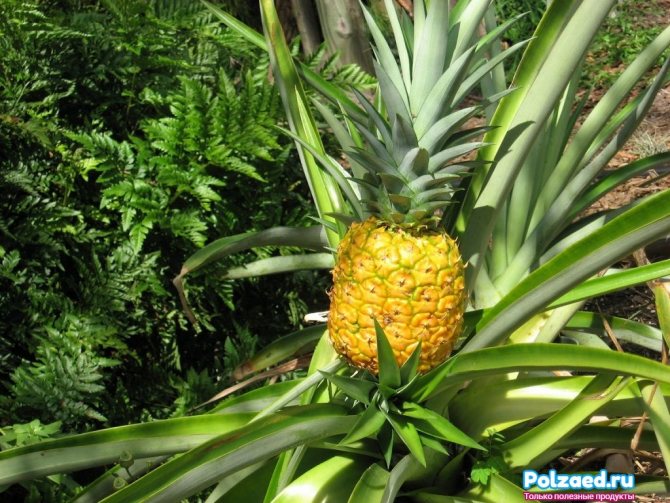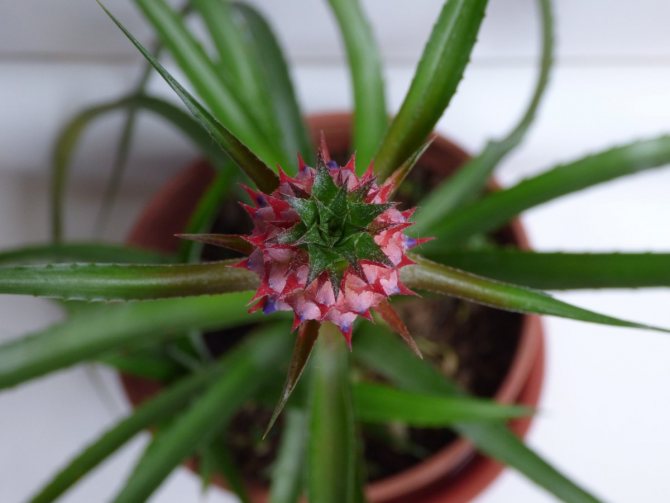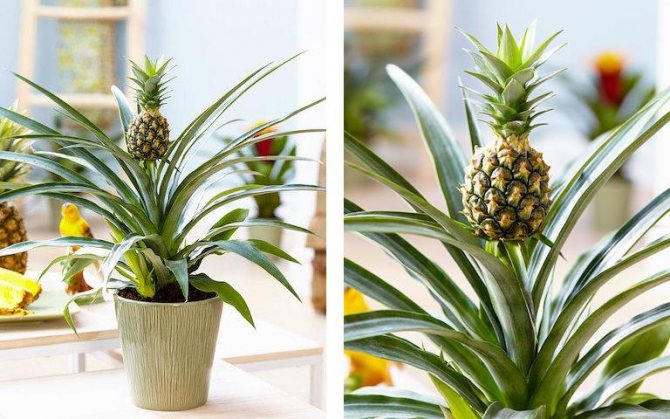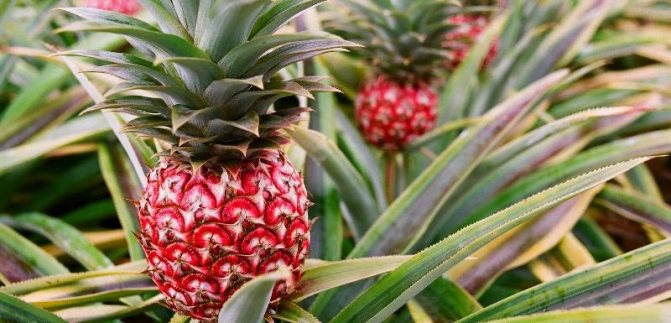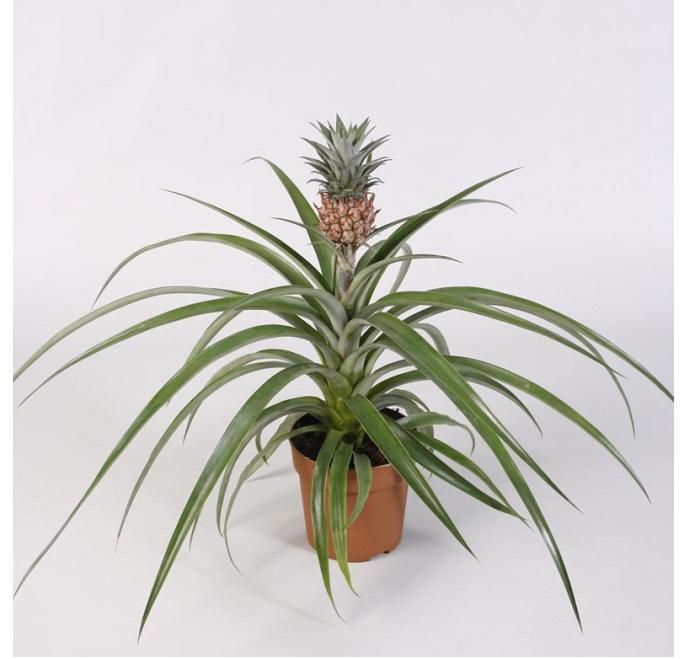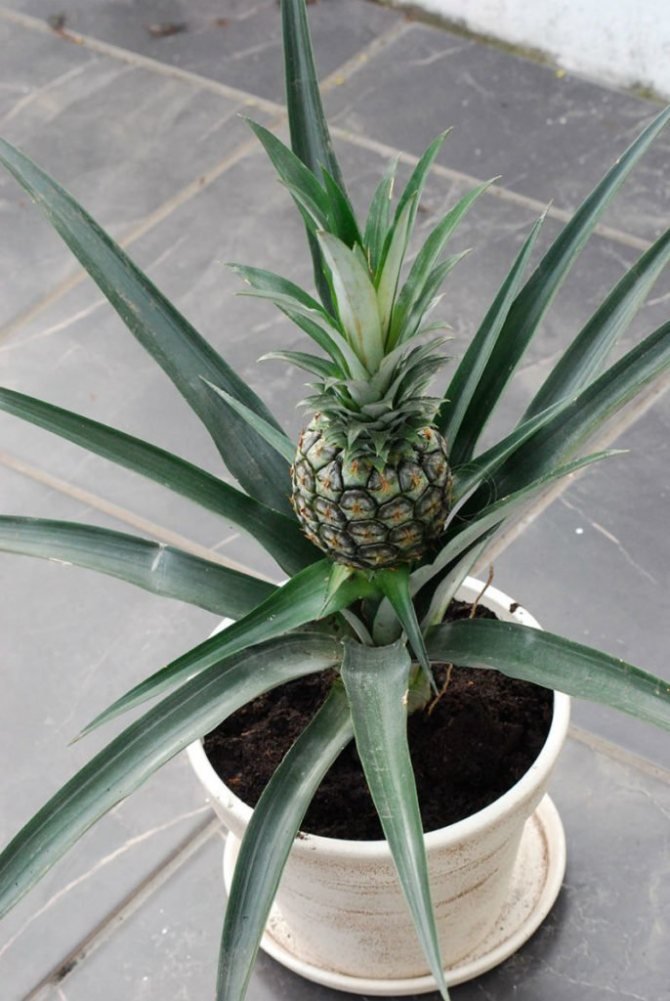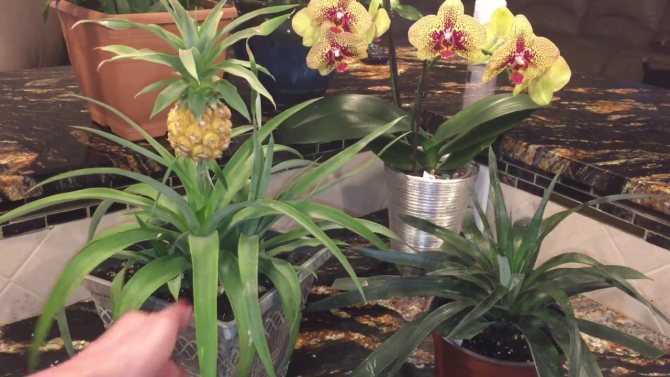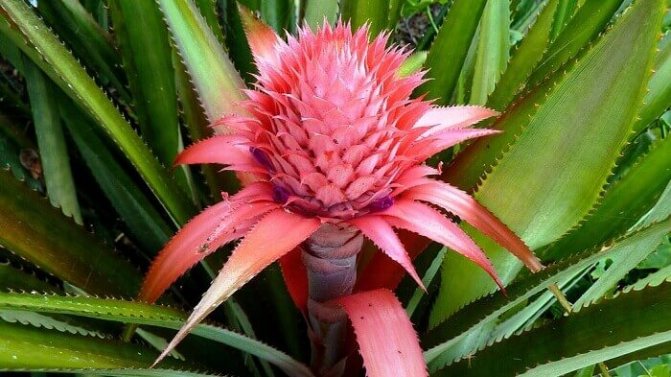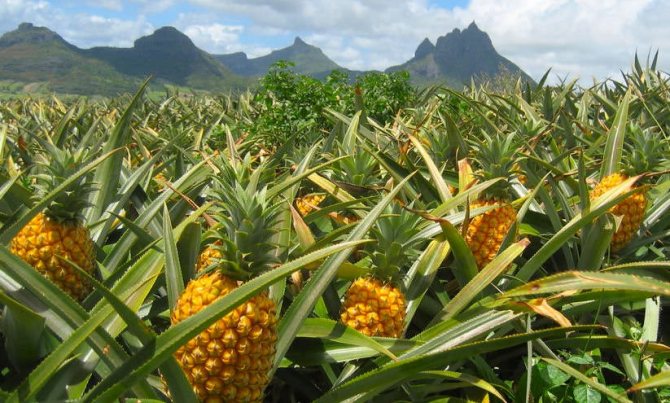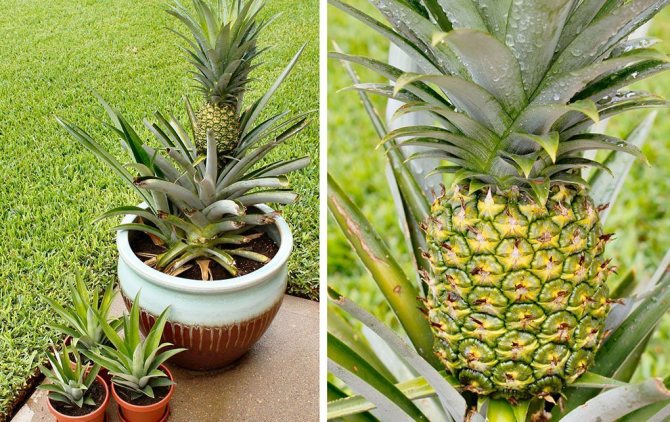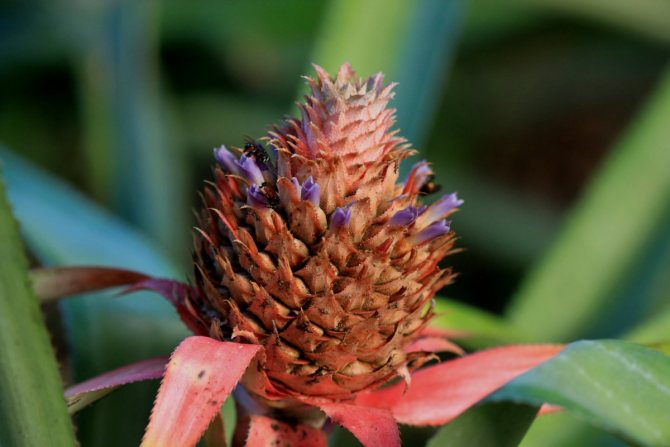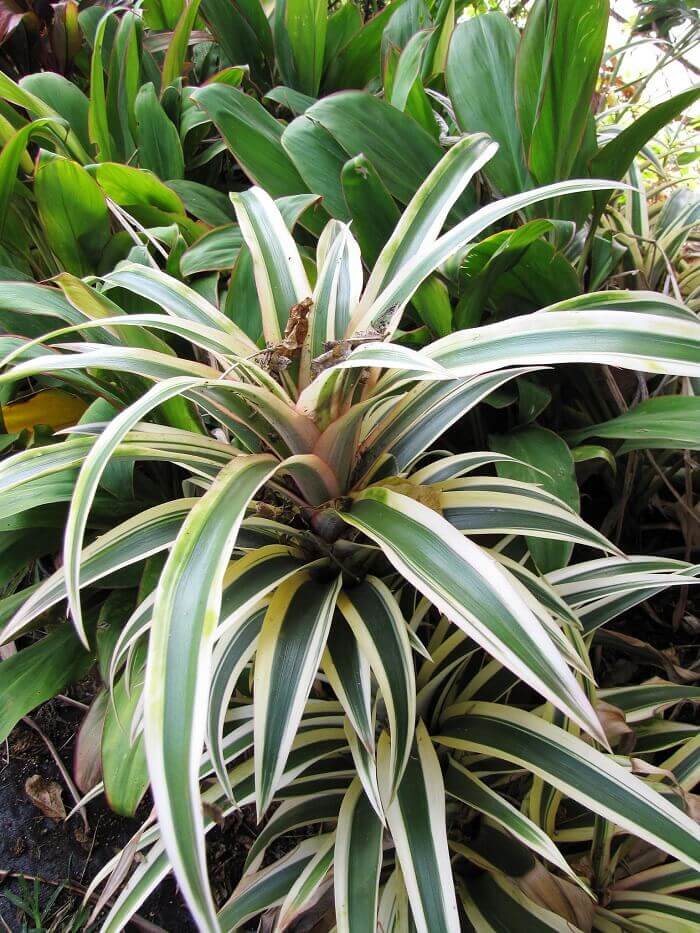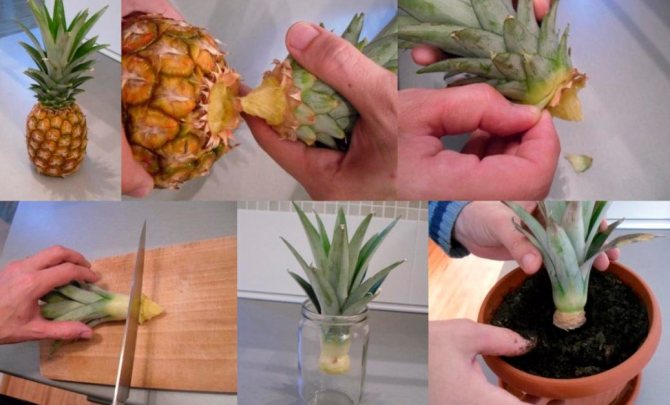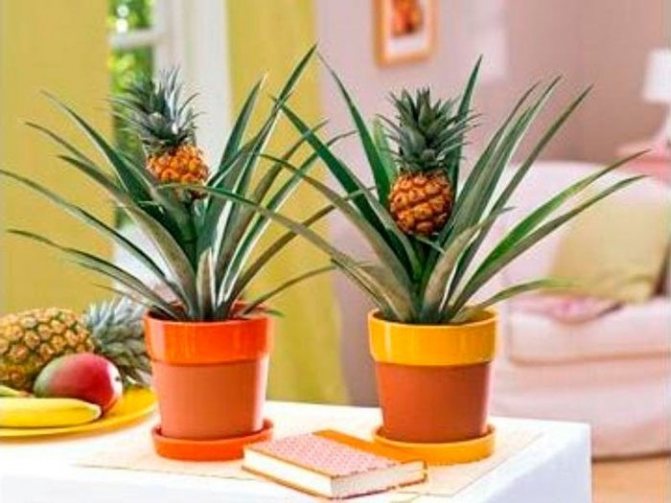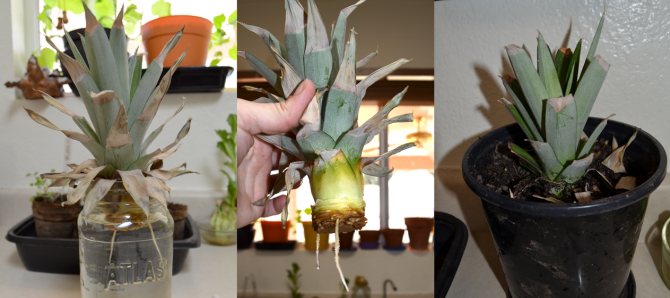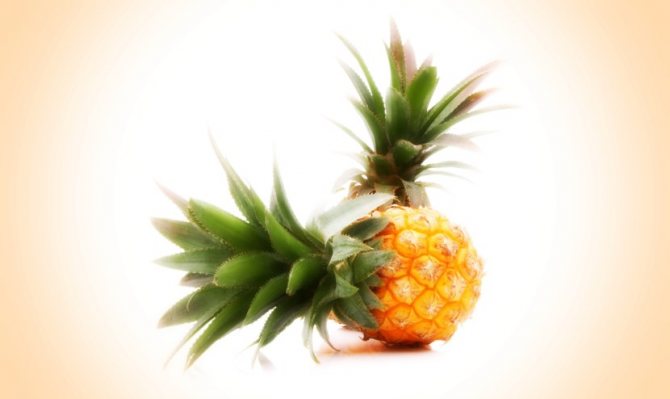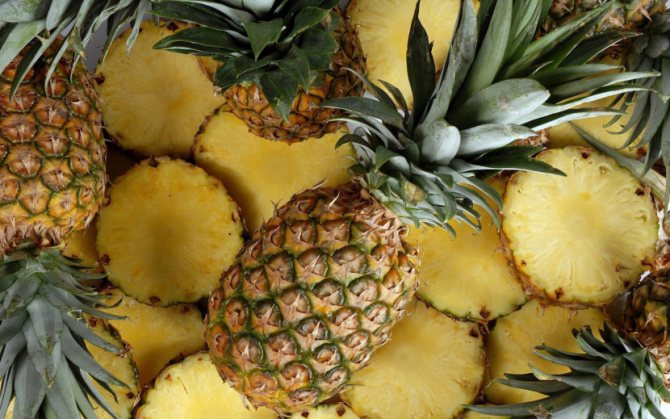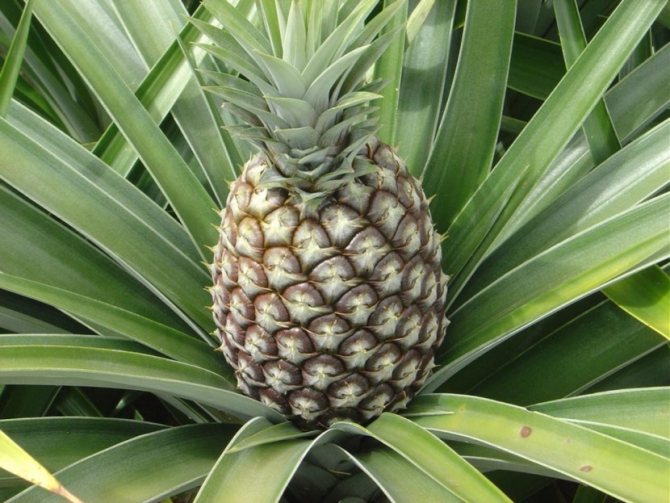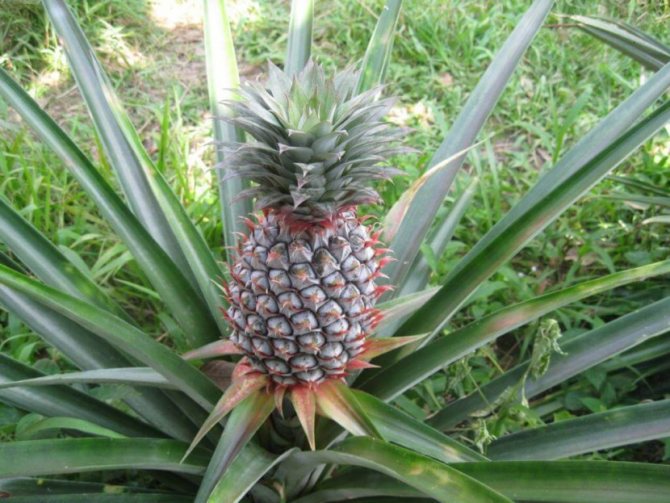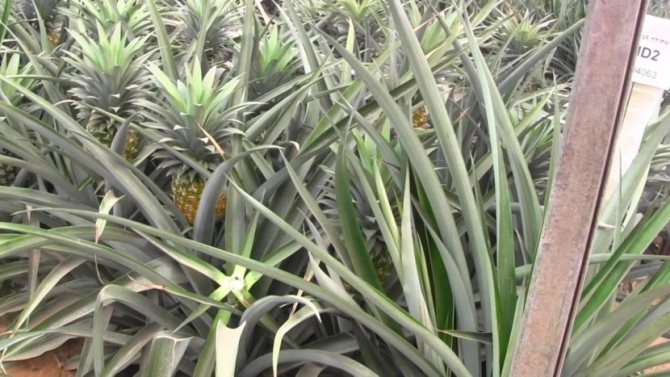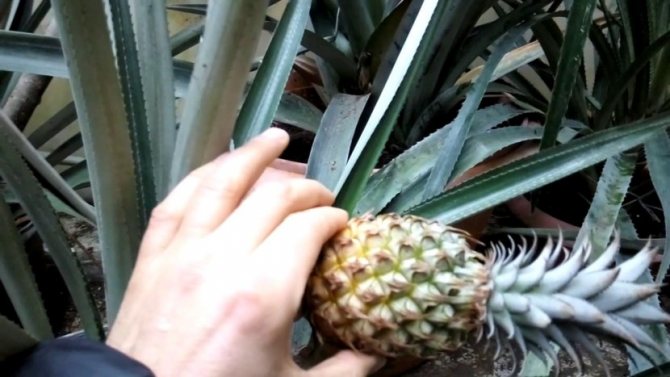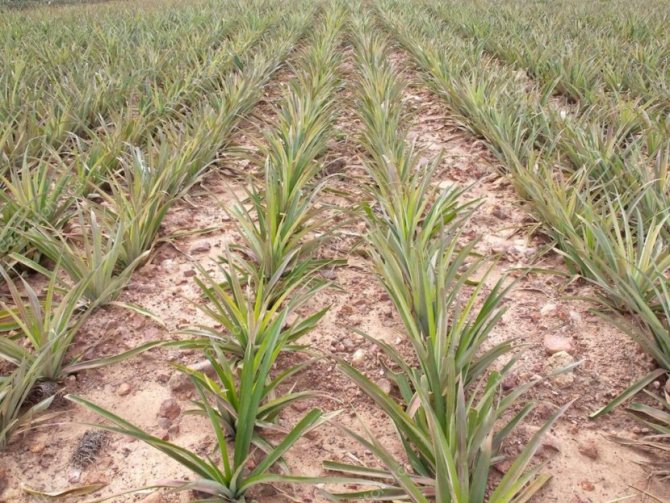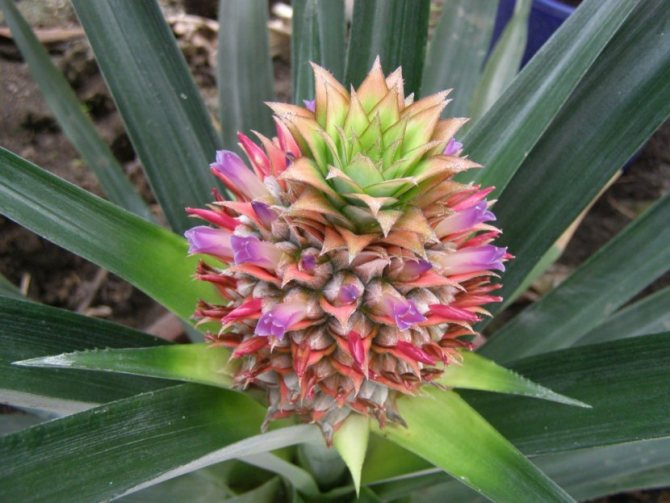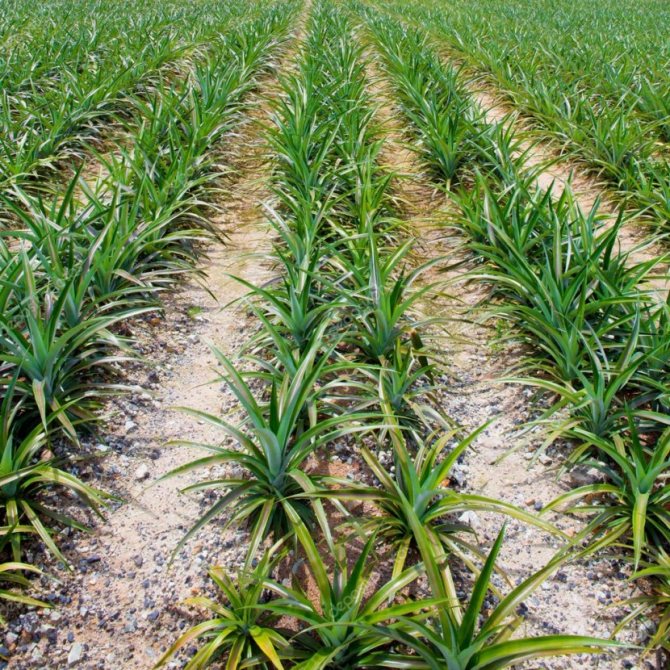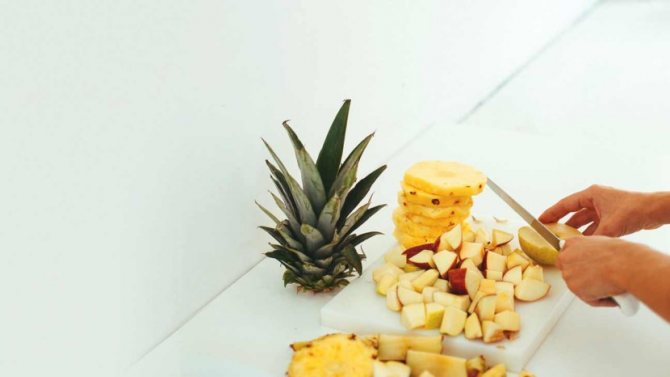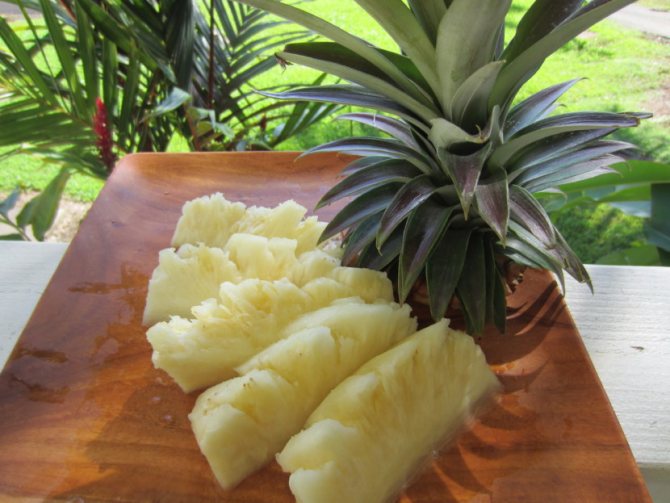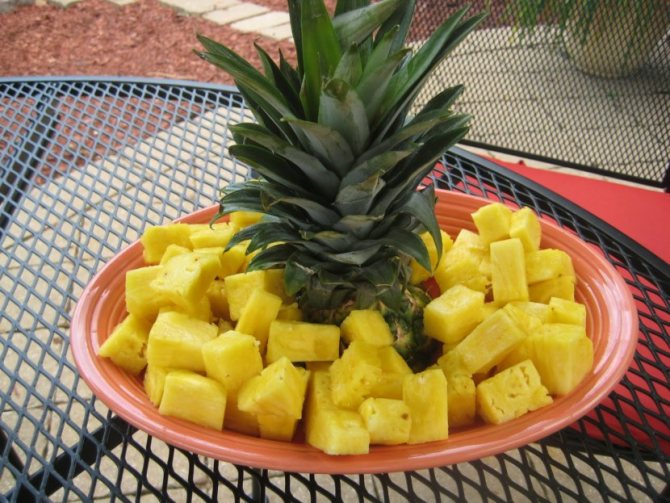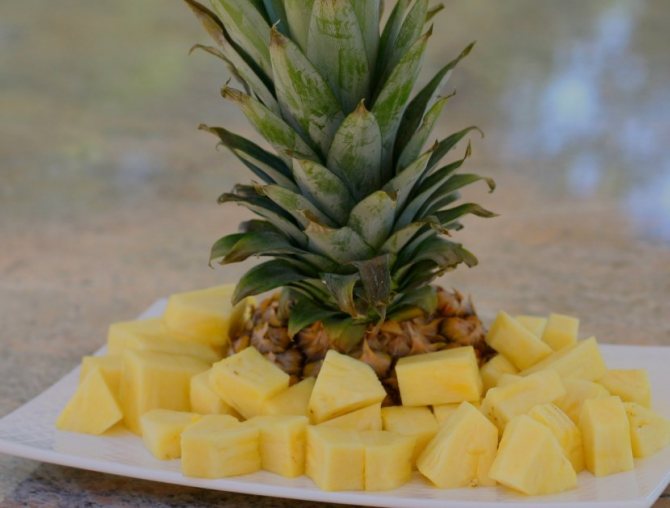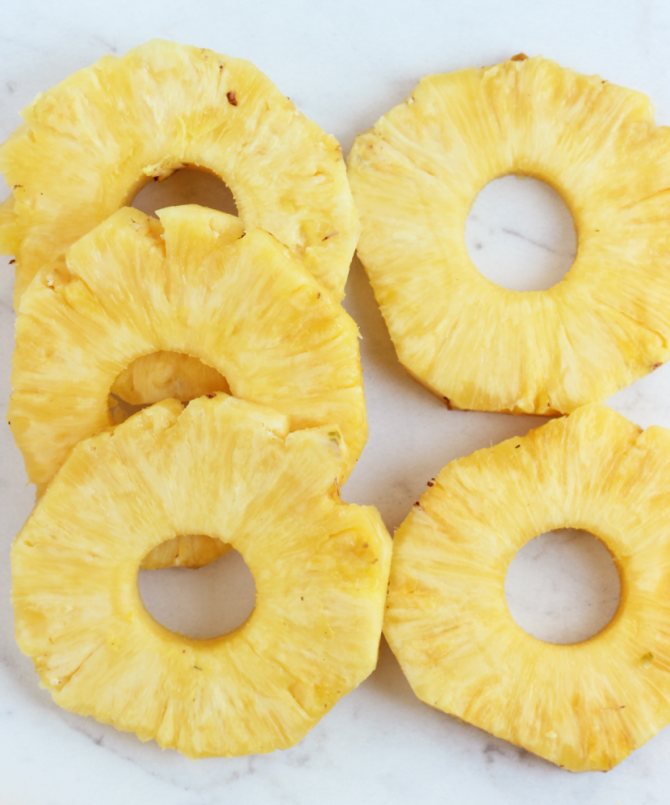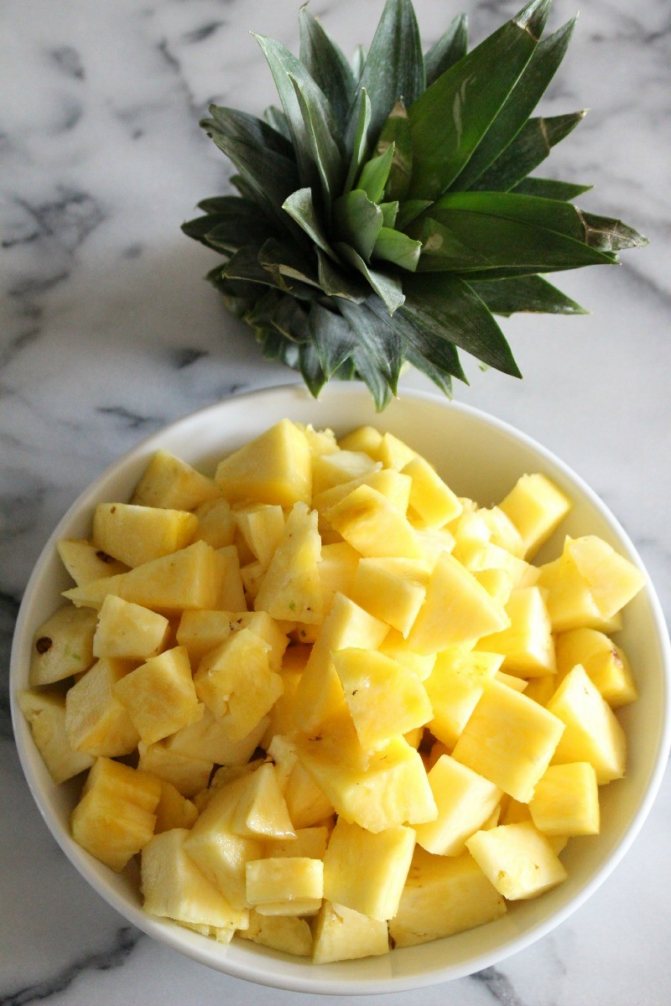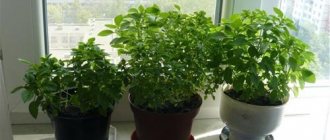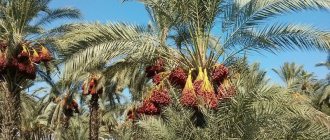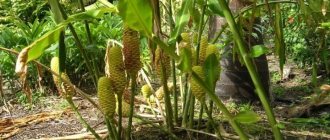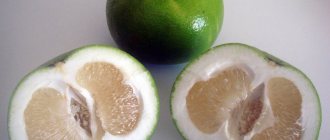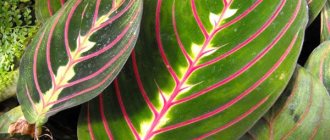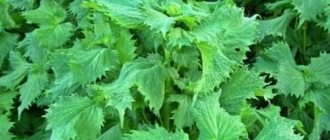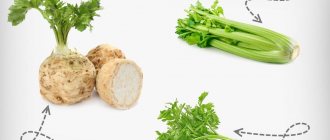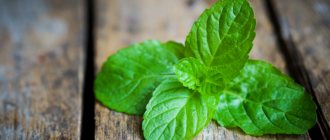Pineapple is one of the most beloved and valuable fruits not only in our country. The recognized king of tropical fruits gives people its freshness in hot countries, and northerners are reminded of summer by its sunny colors and southern aroma.
- 2 Use of fruits
2.1 Useful properties
- 3.1 Distribution of pineapples in the wild
- 5.1 Video: Blooming and growing pineapple at home
Description of pineapple
Pineapple is a perennial; during the growing season it forms dense fleshy leaves, collected by a rosette. Its leaves are succulents, they are able to accumulate moisture in tissues. The length is from 30 to 100 cm. A dense, massive stem grows from the root rosette. The peduncle is formed at the apex, up to 50 cm long. The flowers are spicate; when ripe, a rosette with bracts appears at the apex. The flowering period of an adult plant, 3-4 years old, occurs from May to July. Fruits weighing up to 5 kg, juicy, sweet and sour, look like a large golden coniferous cone with a bunch of short leaves at the top. The root system is weak, 30 cm deep.
How to choose a fruit for planting
Supermarkets have a wide selection of fruits, but not all of them are suitable for growing exotic fruits at home. Small, not fully ripe pineapples are not suitable: the fruits must be large and ripe.
Other important selection criteria:
- the skin is hard, golden brown;
- leaves of a rich color, with a bluish tint, without damage and spots;
- light sweetish smell;
- midges should not hide in the axils of the leaves;
- no dents and rotten areas.
Pineapple propagation is performed in three ways: by seeds, cuttings and the top. The first method is quite laborious, it takes a long time to wait for seedlings, it is very difficult to find a suitable planting material. Adult bushes growing in a dwelling are propagated by cuttings. It is quite simple to start from scratch: buy a ripe pineapple, cut off the top, root it, transplant it into a flowerpot and continue growing exotic fruit at home.
Features and types of homemade pineapple
Under natural conditions, the plant reaches a meter in height, with a diameter of two meters. The room grows only up to 70 cm. Adapted species:
| View | Features of the |
| Bracts | Leaves are one meter long, curved, bright green, on the surface of their white, yellow stripes. When they fade in the sun, they turn pink, red. The tricolor look is popular in indoor floriculture. |
| Large-crested | Linear leaves grow up to a meter, are arranged in a spiral, form a spike-shaped inflorescence. The color of the flowers is purple, pink, red. |
| Dwarf | Dark green, narrow leaves, serrated at the edges, pointed at the end up to 30 cm. For decorative cultivation only. |
| Shiny (black) | Long, dark leaves at the edges with red, brown, bright green shades in the middle. |
| Champaka | Sharp, serrated leaves with conical pink inflorescences. |
| Decorative | Beautiful in appearance with bright bracts and variegated leaves of red shades. |
| Caena | Up to 30 cm high, on a short stalk, edible fruits up to 5 kg in the form of a cylinder. Leaves are not prickly, without thorns. |
| Sagenaria | Two-meter leaves, bright red fruits. |
| MD-2 | The hybrid, with sweet tasty fruits, is resistant to diseases and pests. Distributed on shelves due to long-term storage. |
| Mauritius | Differs in excellent taste. |
Practitioners' reviews
For a long time I had a desire to plant pineapple at home, I was waiting for summer. They say that the winter ones take root very badly, they probably suffered from the cold in some warehouse. It is surprising, but they reproduce with their green rosette tufts. I found a large ripe pineapple with nice green leaves in the store and unscrewed this outlet with my hand, as if I had unscrewed a light bulb from a socket - it turned out quite easily. Then I dried it on the windowsill. A horizontal position and a period of 3 days to 2 weeks are recommended. I dried it for 3 days, I didn't have enough patience. Then I cut off the dried leaves. Further, as they dry up, they are advised to be removed. In the end, there will most likely be one stump, from which sprouts will go. But this is still far away, it will take from one to several months. Endure and care. As a soil for the first planting, I chose sand, I watched in one program that in the homeland of pineapple there are whole sandy nurseries for growing pineapple seedlings. The sand must be clean and damp. In general, this tropical plant needs water and light, as well as warmth, even heat. There is no place for him on a cold floor or windowsill. Another nuance - you need to water the plant in the center of the outlet - there it has special adventitious roots to collect moisture, and also often spray it with warm water, sometimes acidifying it with lemon juice.
KOSCHECHKA-BLACK
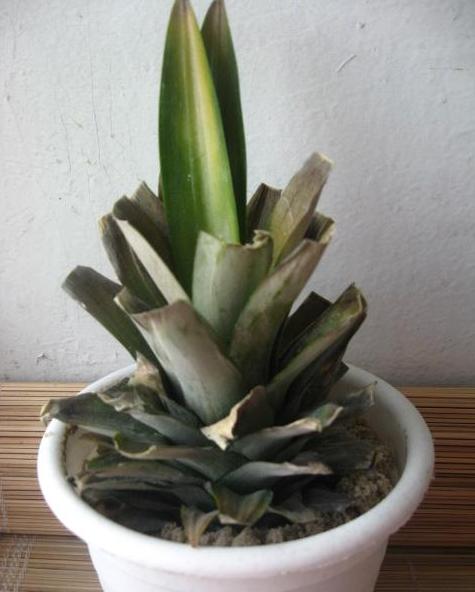
New leafy sprouts of indoor pineapple come from the center of the stump
Once I saw redness inside the outlet, and a few days later a pineapple flower. You know, this is such a delight, as if I saw a fern flower and made a wish. It is a miracle to watch how he releases an arrow with an inflorescence of small red flowers, then each flower turns into the so-called "navel" of which the pineapple fruit consists, and on the top of the head there is a green crest.
Foxy love
Selection and preparation of planting material
The easiest way to grow pineapple at home is from a crown or rosette of leaves. To plant a plant, use a ripe fruit, without signs of diseases and pests. The leaves should be green with no yellow or brown spots, and the skin should be golden brown and firm to the touch.
It is not recommended to take fruit bought in winter, preferably in summer or early autumn.
Preparation of material for planting from the top step by step:
- Carefully cut it off with a sharp knife, without touching the core, or unscrew it with a smooth rotation along the axis.
- Peel the remaining pulp with a knife.
- The lower leaves are removed.
- The cut site is treated with charcoal.
- The cut part is placed vertically to dry for two weeks.
- Later placed in a container with water or prepared soil.
- Dishes with water should be dark, place the top 3-4 cm, not completely.
- After the roots have formed, they are laid on a paper towel to dry.
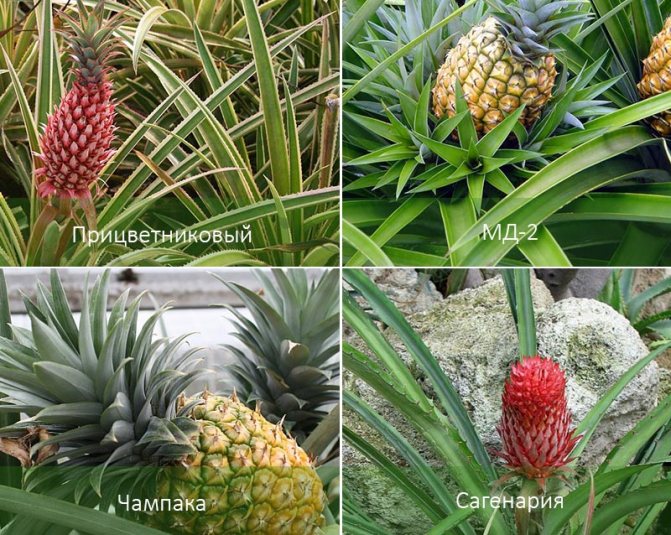

After the actions taken, they are planted in loose and nutritious soil.
Where are these fruits grown?
The homeland of pineapple is the sunny plateaus of Brazil. It was from there that the exotic fruit began its journey around the world. In the 16th century, Portuguese sailors brought pineapple to India and Africa, and in the 17th century Europe also met it. True, European climatic conditions do not allow growing this fruit in the open air, so it was settled here in a greenhouse. In the same way, for a long time it was possible to obtain the fruits of this plant in St. Petersburg and even on the Solovetsky Islands. But in the 19th century, with the development of a merchant shipping company, it became unprofitable to deal with pineapples, since they were brought in large quantities from plantations, and greenhouses refused to grow exotic fruits.
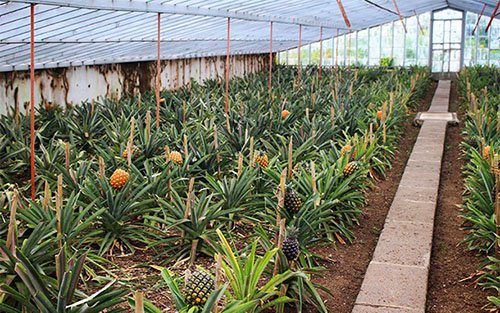

Due to the long growing season, it is not profitable to grow pineapples indoors.
Today, the main large plantations supplying pineapples around the world are in Brazil, the Philippine Islands, Thailand and Taiwan. In Russia, this fruit is grown only by amateur gardeners at home, in pots or in heated greenhouses and greenhouses.
On Valaam, a few years ago, novices tried to root pineapples in the monastery greenhouse, among ordinary vegetables and herbs. The experiment was a success, and today several exotic fruits are ready to diversify the menu of ascetics.


Colombian pineapples get along well next to cucumbers
Distribution of pineapples in the wild
Wild pineapples are still found in their homeland - in Brazil, settling among grass stands or along the edges of forests. Their fruits are much smaller than varietal ones and not so tasty, but, unlike cultural relatives, they retained the ability to reproduce by seeds. In cultivated pineapples, seeds are either absent or do not ripen, therefore reproduction occurs by layering and rooting of the top.
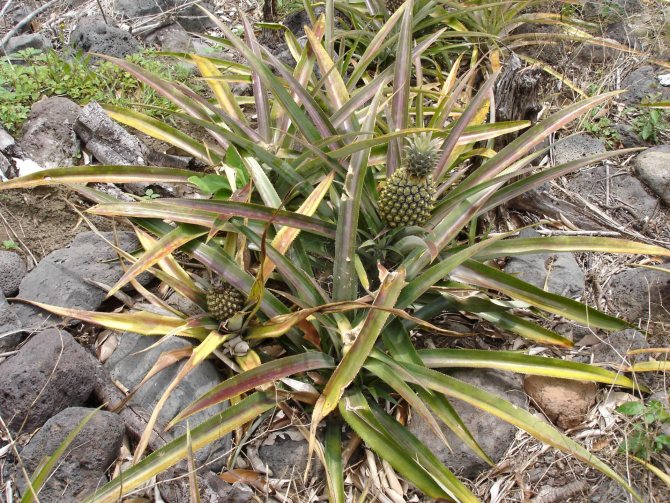

Wild pineapple fruits are much smaller than cultivars
Planting pineapple
For planting a houseplant, a pot with a diameter of 14 cm is selected, a drainage layer is laid on the bottom. Acquire soil for palm plants. Sometimes they cook themselves: sand, humus, leafy earth equally. Previously, the earth is steamed or treated with a solution of potassium permanganate. Planted in moist soil, leave 2 cm to the edge of the container. Cover with foil.
After two months, rooting occurs. This time the ground is only sprayed. The formation of young leaves indicates that the plant has taken root. Old, dry ones are removed. The container is placed in a lighted place. Water so that there is water in the leaf funnel. Flowering is expected in two years.
Top dressing
At the end of February, the growing season begins, which lasts until September. During this period, the pineapple is systematically fed. Fertilize every 10-15 days. This procedure has several features:
- Top dressing can be done with horse or cow manure. Prepare a bucket that is 1/3 full of organic fertilizer. The remaining volume should be filled up with warm water.
- Within 3-5 days, the mixture is stirred periodically.
- Then the solution should stand for a week.
- Then it is diluted with water (1:10). For 1 liter of soil, 50 ml of fertilizer is needed.
- Pineapple should be sprayed with a solution of ferrous sulfate 1-2 times a month (1 g per 1 liter of water).
Do not feed the pineapple with alkaline fertilizers, for example, wood ash or lime is not suitable. You won't be able to grow a healthy plant with them.
Pineapple care at home
Indoor conditions for cultivating pineapple create special care.
| Parameters | Spring Summer | Winter autumn |
| Temperature | + 22 ... + 25 ° С. | + 18 ... + 20 ° С. |
| Lighting | Bright, on the southeast windowsill. | Daylight hours up to 10 hours, additional lighting. |
| Watering | Abundant, after the soil has dried, warm water +30 ° C. | Moderate, once a week. |
| Spraying | Regular, warm showers. | Not required. |
| Fertilizers | Once every two weeks with an organic mixture or mullein infusion. | Not needed. |
Pineapple pruning is not required; with sharp scissors, periodically remove old, dried leaves without touching healthy tissues. A young plant is transplanted every year, and an adult - if the container has become small and the roots come out. This is done by the pass method.
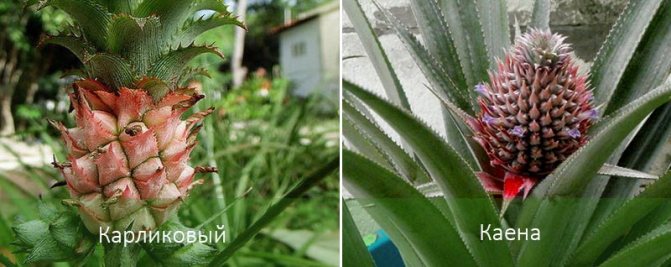

Lighting
Pineapple is a light-loving crop. But direct ultraviolet rays are undesirable for him. It is best to place the plant on the east or west side. Do not put it on the south window.
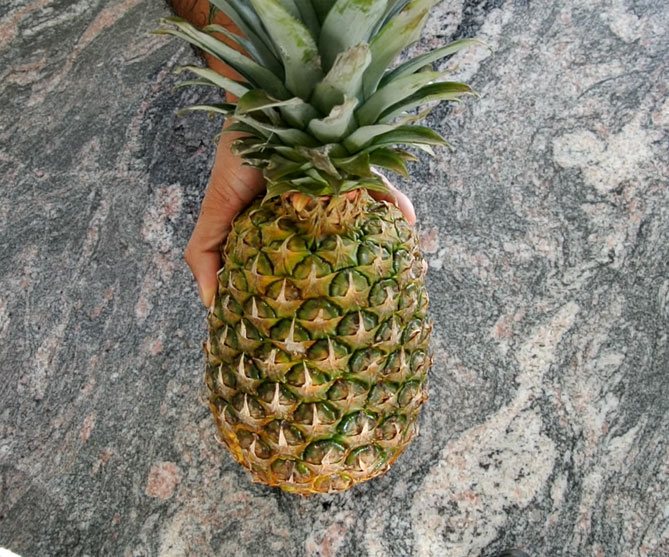

Do not turn the plant. Pineapple develops normally if there is one-sided lighting. Additional light is required in late autumn and winter.A fluorescent lamp should be placed next to the plant at a distance of 20 cm. Pineapple should be illuminated for 8-10 hours a day.
How to stimulate flowering
If, after several years, the plant does not bloom, the process is accelerated using calcium carbide, which releases ethylene. A tablespoon is insisted for a day in a sealed glass container, then filtered. The rosette of leaves is poured with the resulting solution of 50 grams for a week. After a month and a half, a peduncle usually appears. If the plant has not bloomed, it has not reached maturity.
Other ways - put a bag of apples in a bowl with pineapple or once a week make smoke: leave a smoldering paper nearby, a smoking cigarette, and cover the plant. Four procedures are done per month.
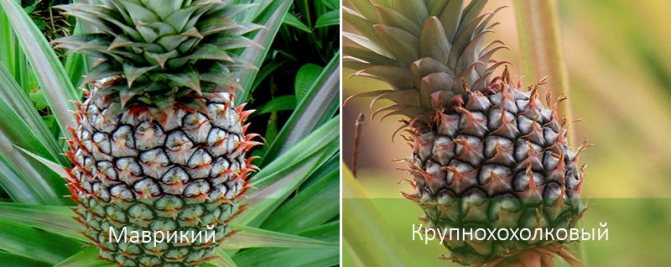

Flowering and fruiting
A pineapple bush grown in a pot has an average height of 50 cm, forming a rosette with leaves that are arranged in a spiral. The first peduncles can appear only 1.5-2 years after planting, and for some varieties - only in the third year of life.


In this case, the growth of the rosette with leaves and the formation of root buds occurs (they can then be used to obtain seedlings). Within a few months, a peduncle is formed with many blue-violet flowers, each of which opens alternately for 1 day. Flowering lasts about 14 days, and after it is over, dried leaves must be removed. The stage of fruit ripening lasts 4-7 months, depending on the variety and conditions of care.
In some cases, flowering does not occur for a long time and then it must be stimulated. It is recommended to use fumigation of the plant or treatment with an aqueous solution of acetylene.
Another method is based on the possibility of obtaining ethylene gas from apples. To do this, the fruits must be cut into 2 equal parts: put one half of the apple cut down on the ground in a pot with pineapple, the other placed on a leaf outlet, and cover the plant with polyethylene for 2-4 weeks. The emitted gas flows to the roots and starts the process of flower emergence. After the beginning of flowering, the halves must be removed and the bag removed.
Reproduction of indoor pineapple
After fruiting, the plant dies, this can happen after a few years. During this time, lateral processes are formed, they are seated separately. They bloom before the top. Cut off or break off the shoots from the mother's outlet when they grow up to 20 cm. Sprinkle the cuts with wood ash. After drying, they are planted.
For the soil, a layer-by-layer option is recommended: sod soil, leaf humus, river sand. Soil temperature + 24 ° С. After planting, they are covered so that the film does not touch the leaves (for this, they put supports).
Seeds are not an easy way to reproduce. First, they are removed from the ripe pulp. Suitable for germination is a semicircular seed 3-4 cm long, brown or reddish. Washed in manganese, dried. For a day, put on a damp napkin, cover the second, put in a warm place for germination. Sow into the ground from leafy earth, peat and sand taken equally by 1.5 cm. Cover with foil. Light is provided by bright, air is warm and humid, watering is regular. Ventilate systematically. Seeds sprout for a long time, from 2 to 6 months. After the emergence of shoots and the formation of the third leaf, fertilize with bird droppings (a teaspoon per liter of water). They dive when they reach 6 cm in height.
Germination of the "crown"
If you decide to grow the pineapple at home from the top, you first need to separate it from the fruit. The operation can be performed in two ways:
- Unscrew the crown. The pineapple is firmly fixed with one hand, with the other they take the tuft at the base of the leaves, turn to the side. The fetus is pulled back a little so that the operation is faster. Usually a quarter of a turn is enough for the crown to separate. The bunch of leaves should sit on a cylindrical fibrous core.
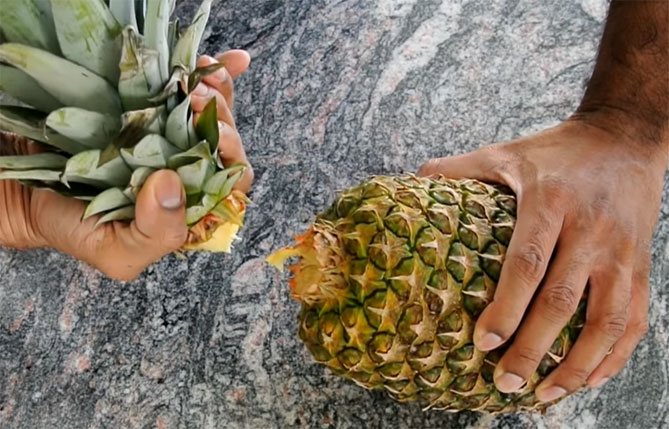

- Cut out the tuft with a portion of the pulp. The knife is buried in the fruit as close to the leaves as possible. Then all the pulp must be carefully cut off so that it does not rot during germination.
In both cases, part of the lower leaves is removed - they are removed one at a time in order to injure less. For a fruit with a rosette larger than 10 cm, peel about 2 cm.For a small one, it is enough to free 1-1.5 cm.
Place the crown of leaves in a dark, well-ventilated place to wither at room temperature. Callus should tighten the wound surface. Enough 1-2 days. Readiness for planting is determined by feeling the cut. It shouldn't be wet.
The top of the pineapple is placed in a warm, bright place for germination, but not in direct sunlight. It is better to take a transparent glassware, put a couple of activated carbon tablets on the bottom, pour clean water.
The roots appear quickly. You can transplant pineapple when their number reaches 10-15 pieces, and the length is at least 2 cm.
Diseases, pests, problems in the care of indoor pineapple
Pests hardly attack the plant if all care conditions are met:
| Problem | Cause | Elimination |
| Slow growth. | Cold air in the room. | Rearranged in a warm place, watered with heated water. |
| The root system is rotting. | High humidity and cold. | Reduce watering, treat the soil with a solution of karbofos. |
| The tips of the leaves dry out. | Low humidity. | Sprayed more often, put humidifiers. |
| Mold on the walls of the pot and in the soil. | Abundant watering in winter. | Remove mold, reduce watering. |
| Light spots on the leaves. | The pest is a false shield. | Treated with a solution of potassium permanganate. |
| White discharge on leaves, slow growth. | Mealybug. | Spray with soapy water. |
| Yellowing, falling foliage. | Aphid. | They are processed with Aktellik. |
| Spider web on the leaves. | Spider mite. | Apply insecticides. |
Temperature
In order for the plant to develop correctly, it is necessary to follow a few simple recommendations:
- The room where the pineapple grows should have a temperature of 22-25 degrees.
- In winter, it should stay within 16-18 degrees.
- If the temperature does not correspond to the desired indicators and the room is very cool, you need to turn on the heating devices.
- If the plant is located on a windowsill, it is protected from drafts and frostbite.
- In the cold, it is advisable to rearrange the culture in the warm part of the apartment.
The right temperature will ensure beautiful flowering and fruiting. It greatly affects the general condition of the plant.
Beneficial features
This fruit is prized for its delicious, juicy and highly aromatic fruits that are eaten both raw and cooked. We can buy it canned, in jams, compotes, juices and many other types. A very important feature is that pineapple contains the enzyme bromelain, which facilitates digestion and helps to lose weight. Fresh fruits contain the most vitamins. Canned fruits lose some of their beneficial properties during processing.


- Pineapple is a great fruit for people who are on a diet because it contains a lot of fiber. Fiber speeds up digestion and removes toxic metabolic products.
- Bromelain, found in pineapples, promotes weight loss, and also acts as an anti-inflammatory, anti-edema and analgesic to prevent blood clots.
- The fruit is used auxiliary in the treatment of cardiovascular diseases, arthritis and other inflammatory diseases.
- The fruits contain disinfectants, and also have the ability to remove dead tissue without damaging new ones, therefore they are used to heal wounds, treat burns, bites, bruises and edema.
- As an adjuvant, they can be used in the treatment of allergies and respiratory diseases, as well as for digestive problems.
- Pineapples are also used in cosmetics. Vitamin C contained in the fruit removes age spots and brightens the skin.
- This fruit strengthens blood vessels. The organic acids and bromelain contained in the fruit gently exfoliate dead skin cells, while minerals nourish it. Pineapples are especially recommended for people with skin pigmentation and acne.
- Pineapple is often used as an aphrodisiac.
Pictures
The presented images of pineapple bushes, flowers and fruits allow you to see the diversity of the perennial plant species.
Snoring Assistant
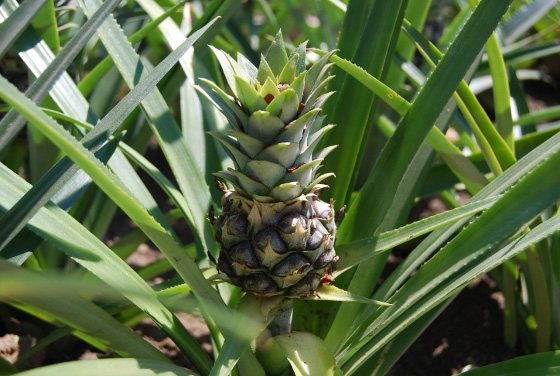

If someone snores a lot in the house, there is a perfect solution. Peaceful sleep will be provided by a pineapple in a pot. Statistics show that the problem of snoring affects one in four adults - usually men.
According to NASA research, pineapple plants produce oxygen and improve air quality throughout the night. Thus, they help you sleep better and quieter. For anyone who has had to run from a bedroom to another room due to their partner's snoring, this discovery can be a godsend.
Plants grow from 21 months to 2 years and eventually give a small fruit. If there is no problem with snoring in the house, they can simply bring a little exotic to the interior.


Pineapple is one of those exotic fruits that we can grow ourselves. It is enough to cut off the top leaf rosette and plant it in a pot. It is very important that this part of the pineapple, which we put in the ground with leaves, is dry, without pulp, otherwise the plant will rot. As a result, we get an ornamental plant that improves the air and can even bear fruit.
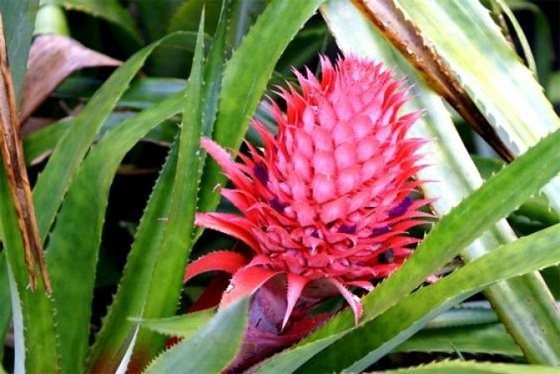

Appearance
In appearance, pineapple is a thorny shrub with large and strong leaves, which are collected in a rosette with an underdeveloped root system. Flower shoots form in the center of the plant with the formation of a single fruit.
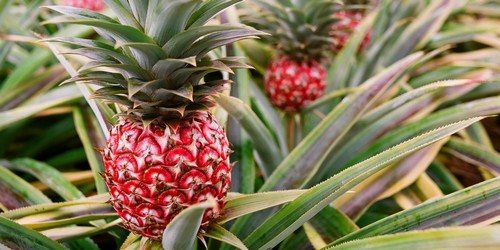

The surface of the fruit is covered with brown scales, and is shaped like a spruce cone. After ripening, the pulp has a golden yellow color with a pronounced aroma and slightly sour taste.
Historical reference
Brazil is considered the birthplace of pineapple, from here the plant spread throughout South America and the Caribbean islands in pre-Columbian times. Locals called the sweet fruit the word "nanas", which is translated from the Indian dialect as "magnificent fruit". It was used not only for food, but also made from its hard and durable leaves mats, fishing tackle, clothes, ropes.
Europeans got acquainted with pineapple at the end of the 15th century during the expedition of Columbus, who gave the fruit the sonorous name "Indian cone" (pina de Indes).
In English-speaking countries, the fruit was called a pineapple.
The Europeans liked the fruit so much that after a few decades, the first pineapple plantations appeared in the Indian and African colonies. Growing pineapples in greenhouses has become fashionable in Europe. This was done even in the vicinity of cold St. Petersburg.
Transplanting a new plant into a permanent pot
Once you have prepared the top and soil, proceed to the next planting step. Make a small hole in the substrate 5-6 cm, but be guided by the size of the seedlings. Before planting, you can fertilize the hole with a small amount of coal (crushed) or ash. Do not plant the bottom pineapple leaves in the soil. The soil must be gently pressed around the plant, do everything gently so as not to damage the sensitive roots.
Immediately after you have planted the top, water the plant with room temperature water. It must be strong. For pineapple cultivation to be successful, create a microclimate suitable for tropical fruits.
It is recommended to build a special makeshift greenhouse. To do this, take a glass jar (you can replace it with a plastic bottle) and polyethylene.Place the pot with the plant in a place with good lighting. At the same time, direct sunlight should not fall on the fruit. The temperature should be comfortable for the pineapple and be around 20-25 ° C.
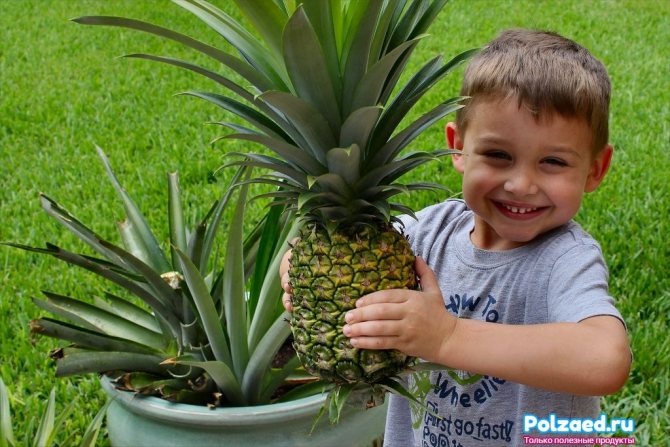

Fetal characteristics
The taste of the fruit is slightly tart and very rich in sweetness. Pineapples are no more than one hundred centimeters high. Leaves help the plant to collect and store moisture at the root. The leaves are no more than two meters long, but these are the longest leaves that a fruit can have. A large number of leaves with fibrous roots, good for strengthening the fruit and creating elasticity.
The roots of the fruit are not as strong as the leaves, and their length does not exceed one hundred centimeters. The coverage of the plane is quite insignificant, and the roots grow, as a rule, downward.
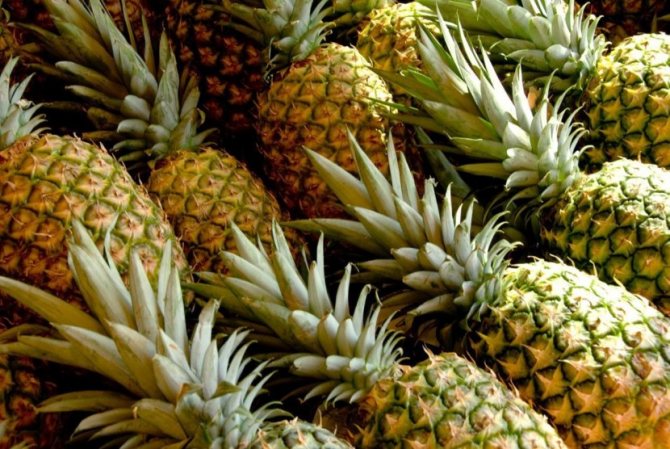

The emerging flowers reach 60 centimeters and curl slightly. Spiral flowers are located at the very end of the shoot, which stretches upward. These shoots bloom about a dozen per day.
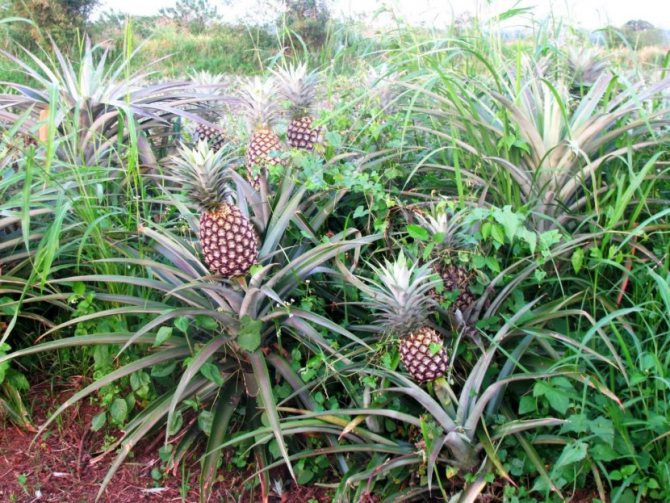

After three weeks, the shoot turns into a mini fruit. Accumulating small fruits form the well-known pineapple. Unfortunately, hummingbirds deprive pineapple of its edible mass through pollination.


The fact is that when a pineapple is pollinated, seeds develop in it, and they spoil the edible part of the fruit. Specialized fruit farms try to avoid pollination and adhere to all safety measures.
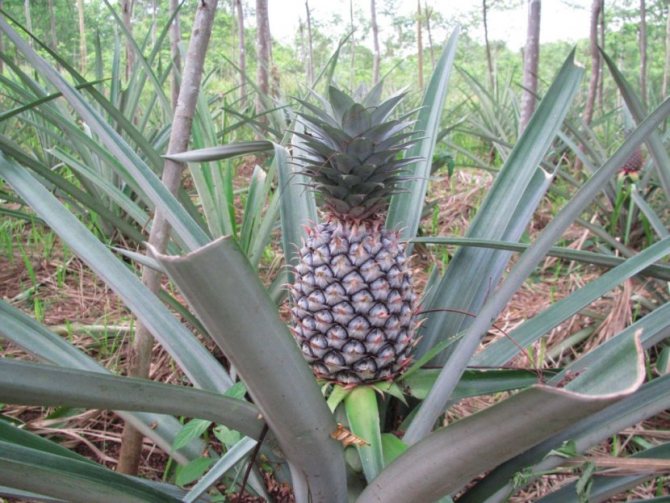

The approximate weight of a typical pineapple is two kilograms, and the top gives the impression of a crown. The crown is created while the pineapple is ripe.
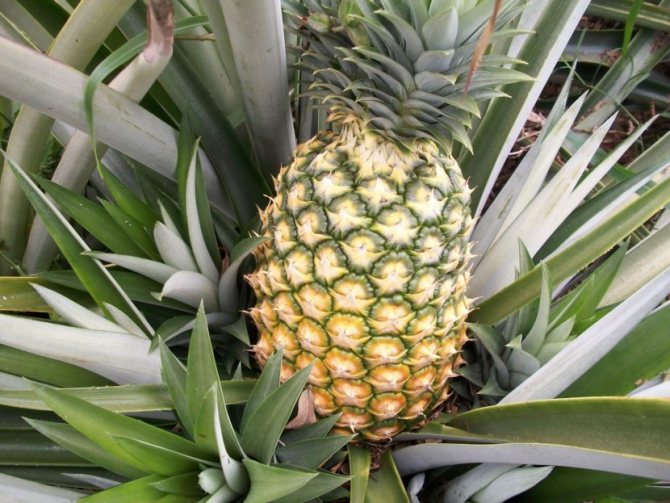

The fruit reproduces by shoots, because they usually do not have seeds. Shoots take root easily, which is very convenient during the creation of a plantation. But if you cross a pineapple, then it will create seeds that can be planted.
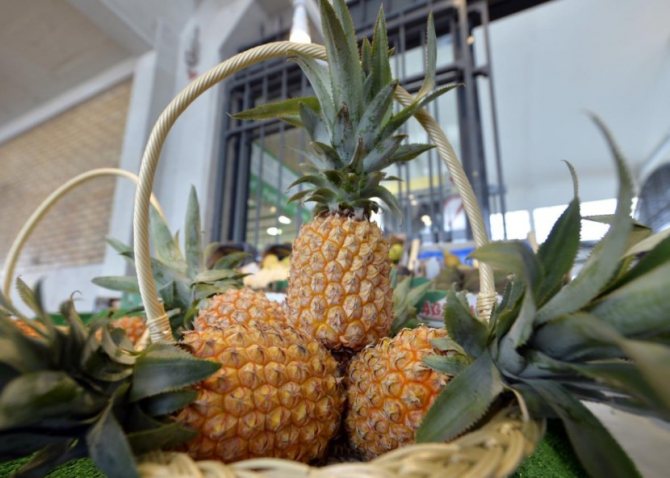

As soon as the first fruit ripens, the plant releases lateral-type shoots, which will further ripen into the fruit. If the shoots are removed from the pineapple, then it will begin to bear fruit again. Immediately after ripening for the second time, the fruit should be uprooted, it is no longer able to bear fruit.


Pineapple seeds are not easy to see, because they look like blotches of white. Conductive bundles are the basis of the fruiting system. It is they who develop the fruit and contribute to its active saturation with moisture from the roots of the leaves.
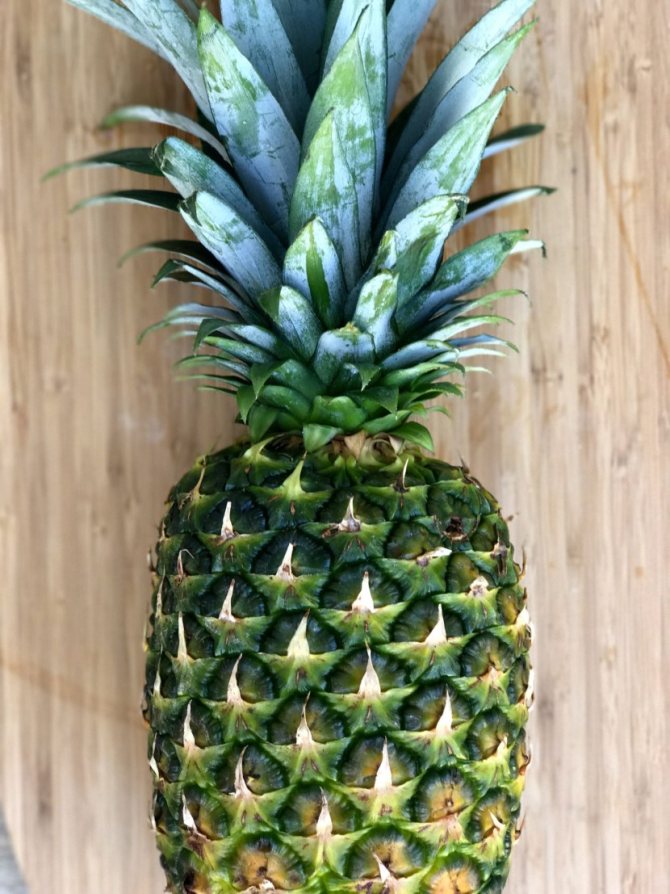

Few people know, but pineapples can easily replace a laxative. Especially fresh or slightly green pineapples that have a spicy flavor.
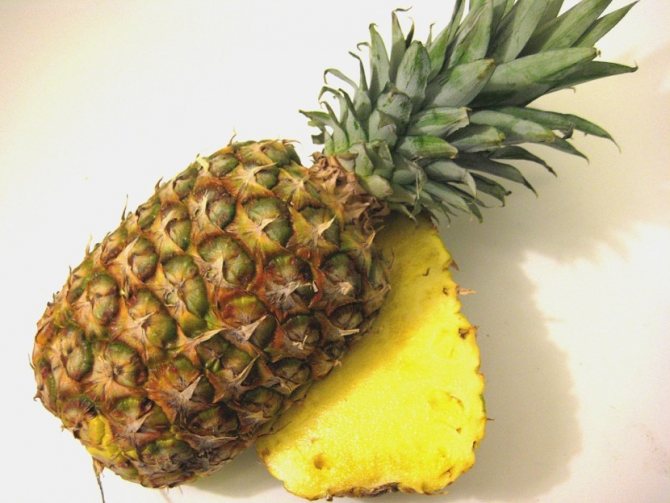

Diseases and their symptoms
Exot requires close attention, since it can be infected with parasites, causing illness and death. Most often, the plant infects spider mites, mealy worms, scale insects or phylloxera. To protect the flowerpot, it is periodically treated with soapy water. It is enough to wipe the palm petals; you can also purchase a special pest repellent. You need to use it as written in the instructions for use. Several signs indicate that the plant is sick:
- Drying leaves.
- Pale color of the plant.
- The top of the leaves are brown.
- Slow growth and lack of flowering.
- Leaves curl.
- Rot at the base.
The causes of such symptoms are not only pests, but also poor plant care. If the first signs of illness appear, it is worth contacting a flower shop, where there is a means to save the plant.
Growing pineapple at home is not easy, but if you follow all the rules, as a result, you can become the owner of a beautiful tropical representative at home and even taste its fruits.
How does pineapple grow on plantations?


Since pineapple has become extremely popular all over the world, farmers are engaged in its cultivation not only in South and Central America, where the plant was first discovered and grew from time immemorial, but also in other regions suitable for climatic conditions. The largest pineapple plantations exist in Asia, South Africa, Australia and the southern United States.
Here the culture is cultivated using intensive technology using large-fruited early ripening varieties. Pineapples fall into the ground in the form of rooted cuttings at least 20 centimeters long. Plants are planted in two rows, leaving a distance of about 1.5–2 meters between individual pineapples and making wider aisles.
The best varieties are able to bloom as early as 12 months after planting in the ground. When the crop is harvested, the plants are harvested, and in their place new ones are planted, obtained from the shoots in the leaf axils.
In the tropics, using mechanized irrigation means, modern pest and disease control drugs, as well as fertilizing and fertilization, it is possible to get up to three harvests a year in the open field.
But not everything is so simple in growing pineapples on plantations. It turns out that in order to get the planned massive harvest, the plants are forced to bloom. If earlier they used ordinary fire smoke for this, today they resort to treating plantings with acetylene. Only under the influence of gas do pineapples on plantations begin to lay flower buds.
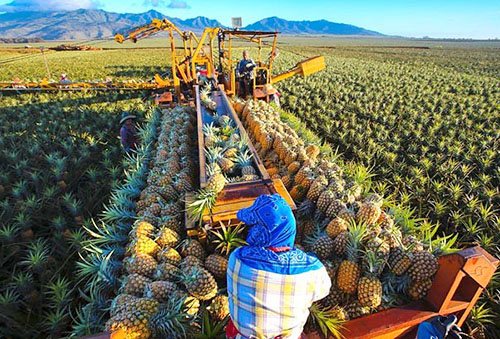

The inflorescence that appears on a long peduncle does not diminish the worries of farmers. It turns out that the ripening of fruits in which there are no seeds or only their rudiments can be achieved by preventing cross-pollination of plants.
For this, protective measures against insects are also used, and even protective caps are put on each inflorescence. Indeed, in Hawaii, for example, plants of this species do not like to pollinate bees or butterflies, but hummingbirds.
Growing in greenhouses
Pineapple is a thermophilic plant. If it can stay for quite a long time without water, then it will not be able to grow without sunlight. Therefore, it is necessary that the premises of the greenhouse are warm and with diffused light. This method of growing pineapples is widely used in Europe and southern Russia. The cultivation technology is slightly different here.
Instead of natural soil, a land mixture is used, which is irrigated with slightly acidified water. This leads to the rapid growth of the plant. There is a special condition here. Watering should not be done with cold water. It should be at ambient temperature. In no case should you flood the plant and let the water stagnate.
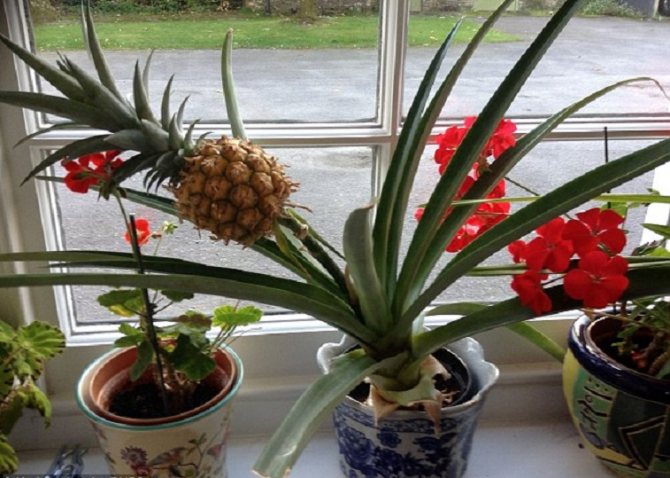

Soil preparation
In the previous paragraph, we learned how to prepare the planting material and start growing pineapple from the top. The soil plays an important role in development. You can purchase a universal mix or specialty soil for tropical and subtropical plants. You can prepare the soil yourself. To do this, take river sand and peat in equal proportions. The substrate must be permeable to oxygen and water.
Before planting, you need to disinfect the soil. To do this, pour the soil with a concentrated solution of potassium permanganate or boiling water. You can plant an outlet after a day. A slightly moist soil is considered optimal for growing pineapple.
